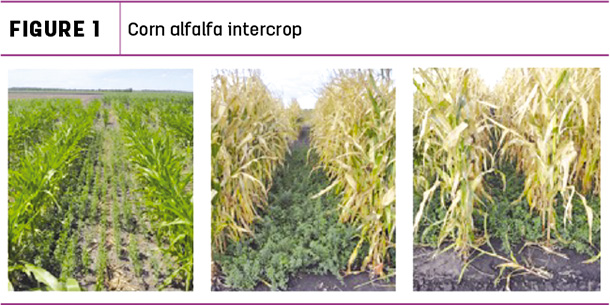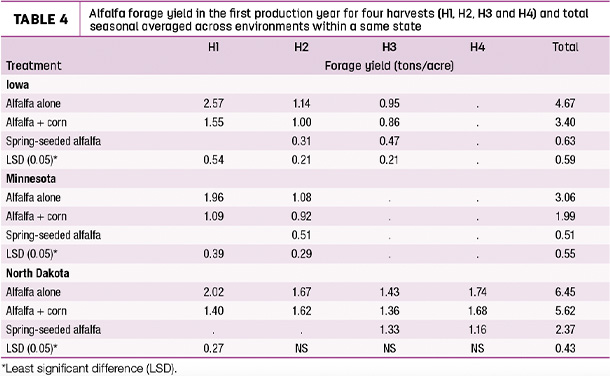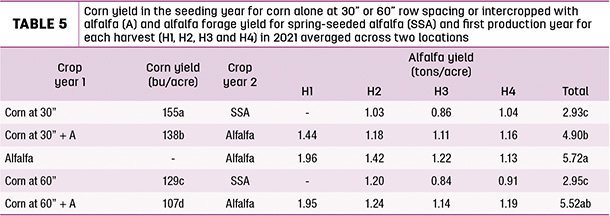The most common crop sequences in the Corn Belt region of the U.S. are continuous corn and corn-soybean. In the last two to three decades, forage-based, more diverse crop rotations have transitioned to less diverse annual crop-based rotations. The increase of farm size, decline in livestock numbers and increase of commodity prices have driven the decline on crop diversity. The reduced crop diversity in the Corn Belt has resulted in negative economic and environmental impacts such as loss of soil organic matter, degradation of soil physical characteristics and increased soil erosion.
Alfalfa in rotation with other crops decreases the production cost of the subsequent crop, due to nitrogen credits and improved soil health. Despite the many economic and environmental benefits alfalfa provides, annual forage yield of alfalfa is much lower than that of silage corn, particularly in the establishment year. This has resulted in the reduction of alfalfa production and subsequent increase of continuous silage corn production on dairy farms. With the approval of glyphosate-tolerant alfalfa in 2011, intercropping alfalfa into a crop to establish alfalfa has become a new potential cropping system for forage growers in the Midwest.
Alfalfa intercropped into corn provides a ground cover after silage corn harvest, providing forage in the subsequent production years. Intercropping alfalfa and silage corn provides a head start to alfalfa production establishment, doubling the forage yield compared with conventional spring-seeded alfalfa. In addition, intercropped alfalfa during and after corn silage production reduces soil, nitrogen and phosphorus losses.
The project goals were to establish alfalfa while growing corn so as to avoid the low-yielding establishment year typical of alfalfa production and increase net grower profits by increasing average alfalfa yield while minimizing impact to corn yield.
Methodology
We conducted several experiments on alfalfa-corn intercropping 2014-21: 2014-17 experiments were conducted at two locations in North Dakota; 2016-19 in North Dakota, Minnesota and Iowa; and 2020-21 in North Dakota. Treatments over the years varied, but common treatments among experiments included 30-inch corn alone, 30-inch corn + alfalfa, alfalfa alone and corn followed by spring-seeded alfalfa in the second year. The experimental design was a randomized complete block design with four replicates. A summary of the results of each one of the experiments from 2014 to 2021 are presented in this article; detailed information of methods and results can be find in the authors’ published work.

In the experiments between 2014 and 2019, a treatment including the application of prohexadione calcium (a growth regulator for alfalfa) was included (results not shown), but since no positive results to alfalfa stand survival were observed, experiments established in 2020 and thereafter did not include this treatment. In 2020 and 2021, experiments of a 60-inch row spacing of corn and corn-alfalfa treatments were added to the study; the first year (alfalfa seeding year) treatments were 30-inch corn, 30-inch corn + alfalfa, alfalfa alone, 60-inch corn and 60-inch corn + alfalfa. In the second year (alfalfa production year), treatments included a spring-seeded alfalfa and the alfalfa established in 2020 alone or in intercropping with corn at 30- or 60-inch corn. All treatments with corn included four rows, regardless of row spacing. Both alfalfa and corn were planted at the same time with two different planters.
Results
In the 2014-17 experiments, the corn silage biomass yield was reduced when intercropped with alfalfa (Table 1); however, the alfalfa established in intercropping with corn had almost double the forage yield in the following year compared with spring-seeded alfalfa following a crop of silage corn (Table 2).


A simple cost-return analysis indicated that when comparing net return after two years of silage corn with corn intercropped with alfalfa, the latter showed a positive return. Extra seed cost and planting cost associated with the sowing of alfalfa, increased the production cost in the first year compared with the corn two-year monoculture. However, lower production cost and higher revenue generated from alfalfa hay compared with silage corn in the second year contributed to the positive net return after the two-year period. When comparing the two systems that had alfalfa, the sequence silage corn followed by spring-seeded alfalfa had a negative net return compared with a positive net return when alfalfa was intercropped with silage corn in year 1, even when the latter had a higher production cost. This is mainly due to the lower forage yield in the spring-seeded alfalfa. Alfalfa intercropped with corn had higher net returns than a silage-corn followed by a spring-seeded alfalfa sequence.
In the multilocation experiments between 2016-19, corn-alfalfa intercropping versus corn in monoculture were evaluated in Iowa, Minnesota and North Dakota. Corn grain yield was significantly lower when intercropped with alfalfa compared with the check corn crop (no alfalfa). Corn grain yield reduction ranged from 14% to 18.8% compared with the check (Table 3).

Corn biomass yield was reduced by intercropped alfalfa by 15.9% to 25.8%.
In the seeding year, alfalfa seasonal forage yield was significantly greater when corn competition was absent in all locations (Table 4).

The intercropped alfalfa from the previous season had almost double the forage yield than the alfalfa in the seeding year (spring-seeded alfalfa) (Table 4). In the second production year, there were no meaningful forage yield differences across all treatments, indicating alfalfa in intercropping systems does not affect forage yield past the first production year. The forage nutritive value was dependent on harvest date, not the alfalfa intercropping treatments.
In the 2020-21 experiments, corn grain yield was not significantly affected by alfalfa intercropping at the same row spacing. Widening corn rows from 30 to 60 inches reduced yield by about 17% without alfalfa intercropped and about 23% with alfalfa intercropped.
Alfalfa total seasonal yield in the first production year was greatest for alfalfa established alone in 2020. Alfalfa coming from intercropped treatments at 30 inches was lower than alfalfa alone (Table 5).

Alfalfa intercropped with corn had four cuts in the first production year, and yield was almost double than that of spring-seeded alfalfa.
Summary
Results of our studies conducted from 2014 to 2021 suggest that establishing alfalfa with corn for silage or grain is feasible and has the potential to get more growers to have alfalfa in the rotation, skipping the typical low forage yield of alfalfa in the establishment year. Although corn grain yield decreases between 15% to 25% due to the competition with alfalfa in the seeding year, the increase in alfalfa forage yield in the following year compared with spring-seeded alfalfa exceeds the monetary losses in corn the first year. However, when under drought conditions, this system might be less resilient, since competition between alfalfa and corn for soil moisture will be intensified under drought or moisture-limited conditions, and this will likely depress corn grain yield.
This research was funded by USDA-NIFA Award 2019-70005-30239 and ND Experiment Station Project ND 01514.
References omitted but are available upon request. Click here to email an editor.










